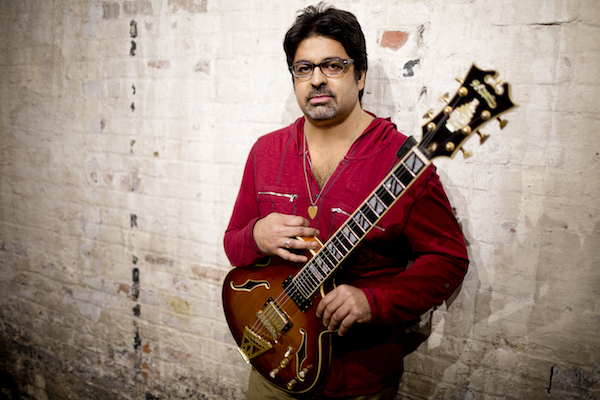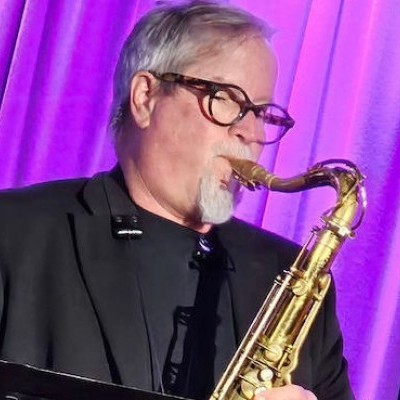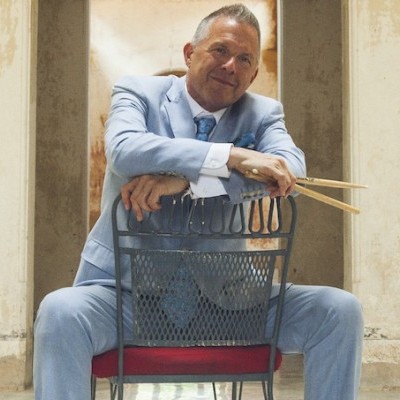Oct 28, 2025 10:47 AM
In Memoriam: Jack DeJohnette, 1942–2025
Jack DeJohnette, a bold and resourceful drummer and NEA Jazz Master who forged a unique vocabulary on the kit over his…

Rez Abbasi
(Photo: Courtesy the artist)While most might associate guitarist Rez Abbasi with his quintet Invocation, there was another side to the artist on display at this year’s ELLNORA guitar festival. With an entirely different quintet, the program was a fascinating program titled Cine-Concert: A Throw Of Dice, with Abbasi’s group playing music he wrote to accompany a 1929 silent film by German-born director Franz Osten about the Indian epic The Mahabharata. Performed in the Krannert Center’s 650-seat Colwell Playhouse on the campus of the University of Illinois, Champaign-Urbana, on Sept. 16, the score was sympathetic, evocative and, in the end, seamless with the film.
Abbasi’s Unfiltered Universe (Whirlwind Recordings) is the third in a trilogy by Invocation, a supergroup which also includes alto saxophonist Rudresh Mahanthappa, pianist Vijay Iyer, bassist Johannes Weidenmueller and drummer Dan Weiss, with the addition of guest cellist Elizabeth Mikhael.
DownBeat caught up with Abbasi at ELLNORA Guitar Festival to discuss these new developments.
How did this piece take shape?
I did a performance at WNYC radio with Sameer Gupta on tabla and bassist Michael Gam in May, 2016. We did an improvised arrangement of Coltrane’s “Lonnie’s Lament” and an original called “Rise Above.” Both the host at the WNYC event, John Schaefer, and the person who heads the New York Guitar Festival, David Spelman, were very pleased. David enjoyed it so much he thought it would be a great idea to expose me via A Throw Of Dice. I was then commissioned by the New York Guitar Festival to write a score.
You have a cultural connection, however distant, to this film.
Culturally, absolutely. If I wasn’t South Asian, I don’t think he would have asked me. And the fact of the matter is, he knew I was a modern component of the South Asian jazz scene, if there is one. And so, he had a light-bulb moment. And, of course, I wasn’t gonna turn that light bulb off (laughs). So, this is the first project I’ve ever done [on this scale]. This will be our second performance. We had our debut in New York in May of this year at the Brookfield Place. It’s the first time I’ve ever had a project that I realized was far beyond myself; that it wasn’t just about me. There were particular directives that I had to follow within the format.
Are there plans to release the music?
Yes. We went into the studio and I’m mixing that right now. It may be my 13th album. It’s come out so well that I feel like we need to be out there in some form. Other than simply being tied to the film. That’s one form I definitely want because it’s almost miraculous how certain musical passages have worked with particular scenes. I can’t even believe I pulled it off.
There are a lot of nests of improvisation within the score. Maybe 70 percent of it is written, but there are all these little nests of improvisation in the score that give it this sort of newness every time you play it. There’s enough to make it different every time. This was my opportunity to bring my modern sensibilities and all my influences to it. And because of the variety of feelings that are in this film, it took me a little time to expose myself to those feelings. There are multitudes of sadness, multitudes of anger. So, I really had to write in a sort of pinpointed fashion. I learned a lot about that, and a lot about pacing myself also.
The movie runs 74 minutes. Is there music throughout?
Yeah, because when you think about it, there might be, like, five-second breaks. And that helps the music, it helps the score. You need some breaks in the music, in general. But, if you think about it, silent film, once you stop playing the music, there’s no noises in the background, there’s nothing else. So, it’s really silent, and it sounds like a mistake unless you do [the silence] judiciously, and with a clever mind to become part of the score.
The new album is the third in a trilogy. The first one, 2008’s Things To Come, was about North Indian Hindustani music, the second, 2012’s Suno Suno, having to do with Pakistan, your home country. When you did Things To Come did you see it as the first of a third?
Not the first album. It kind of dawned on me that it was Hindustani-inflected more so, because my wife, Kiran Ahluwalia, sang on it. But at the same time, I was really into Qawwali music, and all kinds of Carnatic music. And I did a lot of work with Rudresh and a few dance companies. So, all of these influences were garnering at the same time. So, when I was thinking about the second album, that’s when it dawned on me. And these are the three musics of South Asia that I’ve been into most of my adult life.
You reference the abstract expressionist artist Jackson Pollack as an inspiration. What about that?
Part of it is there’s a canvas and I let the paint, if you will, speak to me in order to give back to it. If you drop your agenda enough, the music, the process, will speak to you a lot louder than you expect it to. It will tell you where to go. DB

Jack DeJohnette boasted a musical resume that was as long as it was fearsome.
Oct 28, 2025 10:47 AM
Jack DeJohnette, a bold and resourceful drummer and NEA Jazz Master who forged a unique vocabulary on the kit over his…

“I’ve told students, ‘I don’t mind if you use AI for this or that project,’” says MIT’s Pascal Le Boeuf. “‘But you need to tell me.’”
Sep 18, 2025 11:14 AM
A standard joke when it comes to discussing artificial intelligence, or AI, is that it’s developing so rapidly that…

Chuck Manning Works for NASA … and plays jazz.
Sep 18, 2025 11:23 AM
Congratulations! After years of study, you’ve earned your degree in jazz performance. But let’s face it: Making a…

Always a sharp dresser, Farnsworth wears a pocket square given to him by trumpeter Art Farmer. “You need to look good if you want to hang around me,” Farmer told him.
Sep 23, 2025 11:12 AM
When he was 12 years old, the hard-swinging veteran drummer Joe Farnsworth had a fateful encounter with his idol Max…

“Make time and energy to meet people and make friends,” suggests Millie Ahearn, a student at DePaul University.
Sep 18, 2025 11:32 AM
For many students, the transition into a collegiate jazz program can feel overwhelming — new peers, unfamiliar…